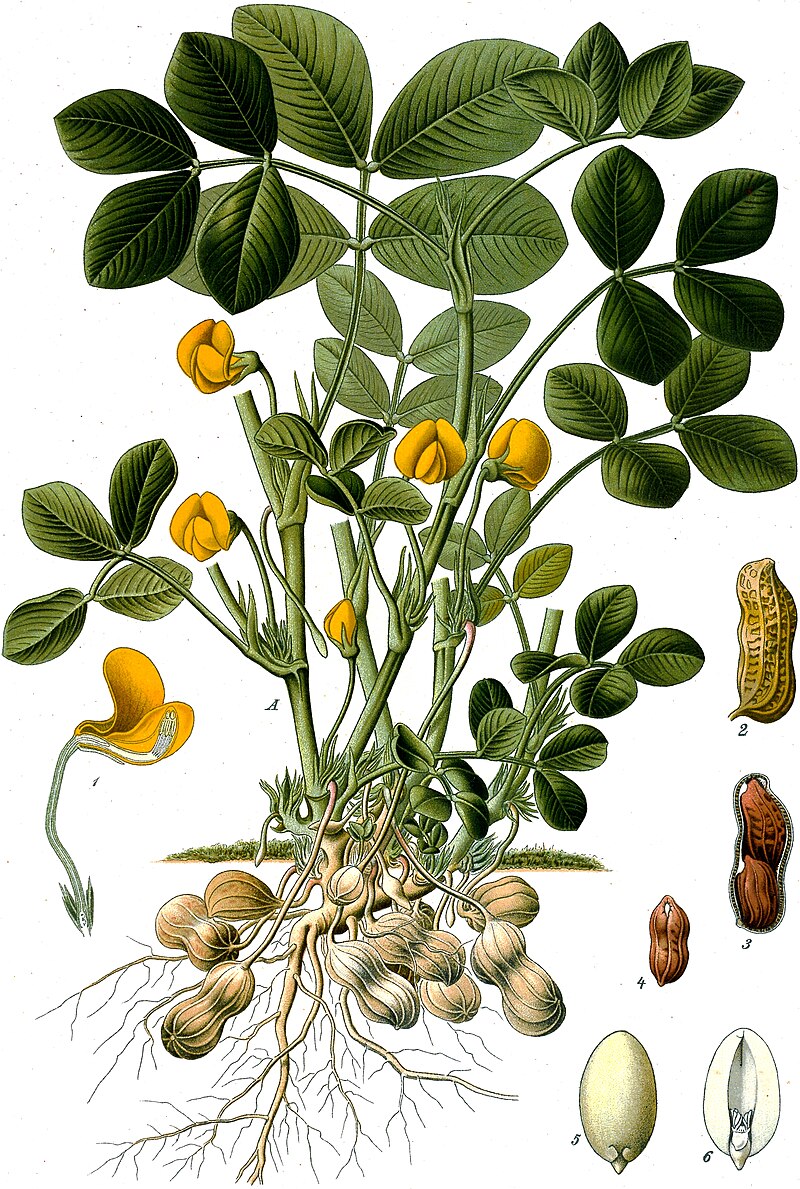The cultivated groundnut (Arachis hypogaea) was probably derived from the wild, A. monticola, which is native to north-western Argentina, and freely hybridizes with it.
The oldest archaeological records of groundnuts are from Peru dated 5000–4000 BP. However, their ancestry is probably much older, and their cultivation may have actually begun in Bolivia where more robust types with less fragile pods were selected from A. monticola.
Documentary sources have noted that Andean peoples “were not only aware of the high nutritive value of peanuts but had varying medical and ritual uses for the plant … in Inca society, peanuts were eaten toasted or combined with honey to make marzipan-like cakes. More recently, sources mention they were eaten roasted, fried, salted, boiled, ground, mashed, used as additives in sauces, or fermented into chicha de maní (a fermented peanut beverage) … Peanuts have had many perceived medicinal properties, including aphrodisiac effects … During the early Colonial period, peanuts were often featured in performative ritual. In Inca society, they were among a handful of select crops incorporated in offerings to the creator god Viracocha” (Masur et al., 2018).
When the early Spanish and Portuguese explorers arrived in the New World, peanut was being grown extensively in South America, Mexico, and the Caribbean Islands. Most authorities credit the Portuguese with introducing the groundnut from Brazil to Africa, the Malabar Coast of Southeastern India and perhaps the Far East. It was introduced to the west coast of Africa in the early sixteenth century by slavers, carried originally as provisions, and by the 1560s was being widely cultivated in Guinea. The peanut was introduced to East Africa in the mid-1500s from Asia, and by the nineteenth century was an important food crop across much of Africa.
The peanut was first introduced into China in the early 1500s by either the Portuguese themselves or by the Chinese merchants of the South Sea islands who came in contact with them. Another possible route of the peanut to China was by the Spanish from Peru. These peanuts had moved up the west coast of South America from Peru to Mexico, and from there likely traveled on the Acapulco–Manila galleon line of the Spanish to the Philippines. Chinese traders and settlers were likely responsible for the further dispersal of the peanut across the rest of Southeast Asia and Indonesia. By the nineteenth century, peanut had become an important food crop across much of China.
The peanut was distributed to North America in the 1700s by slave ships. Peanuts were grown in the southern US during the 1700s and 1800s but remained a regional food until after the Civil War when its demand increased rapidly with the development of better equipment for harvesting and processing and a growing fondness for peanut butter. The first patent for peanut butter was filed in 1895 by the doctor, nutritionist, and cereal pioneer John Harvey Kellogg. His concoction involved boiling nuts and grinding them into an easily digestible paste for patients at the Battle Creek Sanitarium, which treated people with all kinds of ailments.
Illustration: Arachis hypogaea (peanut). Köhler’s Medizinal Pflanzen
Bibliography:
Carney, J.A. and Rosomoff, R.N. (2009) In the shadow of slavery: Africa’s botanical legacy in the Atlantic world. University of California Press, Berkeley and Los Angeles.
Gregory, W.C., Krapovickas, A. and Gregory, M.P. (1980) Structure, variation, evolution and classification in Arachis. In: Summerfield, R.J. and Bunting, A.H. (eds) Advances in Legume Science. Royal Botanical Gardens, Kew, pp. 469–481.
Hammons, R.O., Herman, D. and Stalker, H.T. (2016). Origin and early history of the peanut. In: Pattee, H.E. and Young, C.T. (eds). Peanut science and technology. American Peanut Research and Education Society, Yoakum, Texas, pp 1-20
Ho, P. T. (1955). The introduction of American food plants into China. American Anthropologist 57(2): 191-201.
Masur, L. J., Millaire, J. F., and Blake, M. (2018). Peanuts and power in the Andes: The social archaeology of plant remains from the Virú Valley, Peru. Journal of Ethnobiology, 38(4), 589-609.
Sauer, J.D. (1995) Historical geography of crop plants: A select roster. CRC Press, Boca Raton, Florida.
Singh, A.K. (1995) Groundnut: Arachis hypogaea (Leguminosae – Papilionoideae). In: Smarrtt, J. and Simmonds, N.W. (eds) Evolution of Crop Plants. Longman Scientific & Technical, Harlow, UK, pp. 246–250.
Stalker, H.T. (2013) Chapter 9. Peanut. In: Singh, M., Upadhyaya, H. D., and Bisht, I. S. Genetic and genomic resources of grain legume improvement. Elsevier Inc.
Wheeling, K. (2021) A Brief History of Peanut Butter; The bizarre sanitarium staple that became a spreadable obsession. Smithsonian. https://www.smithsonianmag.com/innovation/brief-history-peanut-butter-180976525/
